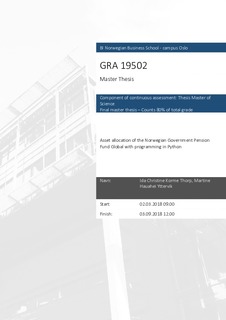Asset allocation of the Norwegian Government Pension Fund Global with programming in Python
Master thesis
Permanent lenke
http://hdl.handle.net/11250/2579687Utgivelsesdato
2018Metadata
Vis full innførselSamlinger
- Master of Science [1621]
Sammendrag
This thesis aims to assess if the optimal asset allocation for the Norwegian
Government Pension Fund – Global could be improved. We were curious to see if
we were able to optimize the portfolio by only looking at the risk-return
relationship, without taking political, economic or ethical interest into evaluation.
Since Norges Bank Investment Management has expressed that they do not have
the absolute answer for what is the optimal asset allocation, we were interested to
research whether or not we could obtain better results by purely examine the
financial performance. The research set out to calculate the optimal portfolio
weighting from historical data collected from 2008 until 2018. To analyze and
compare the results we used the FTSE Benchmark Index, which is the benchmark
used for the Government Pension Fund – Global. Therefore, we tried to replicate
the FTSE benchmark by using 25 of the same countries in our portfolio. Upon
advice from our supervisor we chose to program our own portfolio optimizer from
scratch with Python as our programming tool. We constructed the different
portfolios and divided them into constant expected return and time-varying
expected return. Even though this was much more time consuming than using
another software, we found it to be rewarding. As expected, our results showed
that with our asset allocation we did not outperform the benchmark, except one
portfolio that is rather close. However, this portfolio was closer than one should
assume – compared to the benchmark Norges Bank uses that has considerably
more complexity and more political-economic decisions behind its investment
strategy. So – is it possible to rather concentrate on the return and variance tradeoff
instead off introducing the vast complexity of several influencing factors.
Beskrivelse
Masteroppgave(MSc) in Master of Science in Business, Economics/Masteroppgave(MSc) in Master of Science in Business, Finance - Handelshøyskolen BI, 2018
